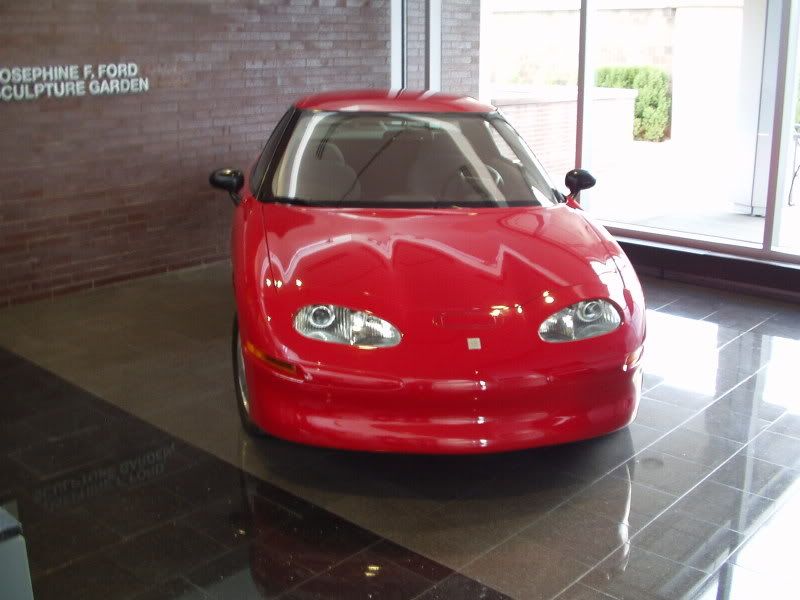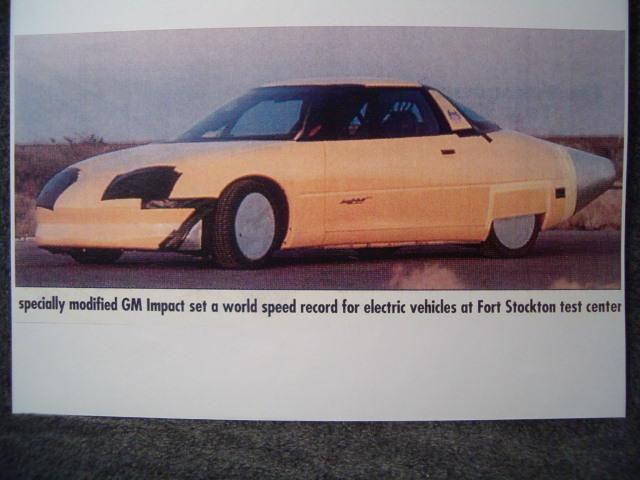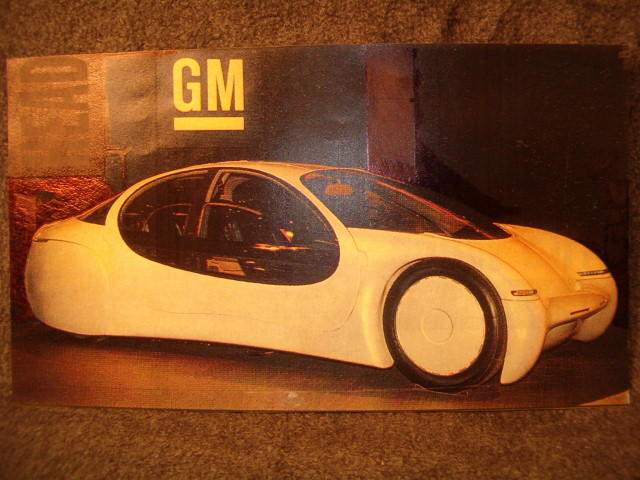I thought I would post the "numbers" portion of this thread now, and see if we can reach agreement on my methodology.There are images of the car in the archives in my aerodynamics photos album.
For references,I have relied on:EV1.THE ELECTRIC CAR.copyright,General Motors,1996; CAR and DRIVER,June,1994,p.94; MVP COMMUNICATIONS INC.,Troy,Michigan' "GM ELECTRIC VEHICLE,Ft.Stockton,B-ROLL";MECHANICAL ENGINEERING,October,1999,pp 74-77.
Brief History:

(Source:
http://www.avinc.com/glossary/gm_impact_ev)
The EV-1 began life in 1988,as the" Impact",developed for GM by Aerovironment,Simi Valley,California,under the supervision of Dr.Paul MacCready.Impact went from a sheet of paper to a functional prototype in 18-months,and bowed at the Greater Los Angeles Auto Show in 1990.
After four permutations and assistance from Delco-Remy,Delco Electronics,GM Aero Lab,and Hughes Aircraft Co., the"raindrop" car emerged on the market in 1996,as a lease-only EV-1,handled through GM's newly-created Saturn Corp.
Constructed at the Reatta Craft Center,Lansing,Michigan,the EV-1 was to achieve compliance for Zero-Emission-Vehicles mandated by the California Air Resources Board,which would allow GM to sell the rest of it's products in California,starting 1998.
---
Mechanical specs of interest to ecomodders are:
 (source: http://ecomodder.com/forum/showthrea...-56k-5598.html)
(source: http://ecomodder.com/forum/showthrea...-56k-5598.html)
Height-1281mm ( 50.5 inches )
Width-1766mm ( 69.5 inches )
Frontal Area 1.9468 square meters ( 21.025 square feet )
Cd 0.188
Drag Factor ( CdA ) 0.366 square meters ( 3.9528 square feet )
Length 4309mm ( 169.7 inches )
Fineness Ratio 3.360:1
Power 102.2 kW ( 137-hp )
Voltage 312-VDC ( @ pack )
Tires P 175/65R 14 Michelin Proxima RR all-season radial with puncture-sealant
Curb Weight 1350 kg ( 2970 pounds )
Performance: Top Speed 129 km/h ( 80 mph )[electronically-limited].
***************************************
Land speed record & modifications

During March 10-11,1994,the pre-production EV-1 was modified and run at the Bridgestone/Firestone Proving-Grounds,Ft.Stockton,Texas,for an attempt at the land speed record for electric cars.
The following modifications were performed for the event:
- The car's interior was gutted save for one racing seat.
- A complete roll-cage was installed.
- The car was lowered 25mm ( 1-inch )
- Windshield wipers and sideview mirrors were removed.
- The cowl area was covered by a plastic panel and duct tape
- Full-coverage wheel discs were screwed to the rims
- A "six-pack",containing extra batteries was installed in the front passenger seat location,boosting voltage to 384-VDC
- The LLR tires were replaced with Z-Rated Michelin tires.
- "Race" weight is estimated at approx. 1573-kg ( 3460-lbs )
Vehicle envelope parameters based on mods are as follows:
Due to the 222.5mm ( 8.9 inch ) differential in wheel track from the front to rear,with the 25mm lowering,the car loses 0.0143 square meters ( 22.9 square inches ) frontal area.
As mirrors do not factor into EPA frontal area,their loss difference is factored as a function of" points."The EV-1 served as the aero "mule" in the development of the GM PNGV car,and 15-points were "allowed" for the mirror delete.(I will use this value in my computations).
Using delta-Cd 0.006 for the wheelcovers ( from John Shinella's Lockheed,Marietta,GA Trans Am Pontiac research ),the modified Cd is estimated at 0.167,frontal area 1.8451 m-sq ( 19.9278 ft-sq ).
Allowing for the increased voltage,the motor power is estimated at 125.784 kW ( 168.615 hp).
Available power is estimated using Mu= 95% ( given simple gearbox and high inverter efficiency at max. load ),for 119.497 kw ( 160.18 hp ) at the drive wheels.
With this setup,the car achieved 288.3 km/h ( 178.8 mph ) top speed ( a land speed record ).
Aerodynamic power requirements at top speed are calculated at 96.871-kW ( 129.854-hp ),leaving 22.622 kW ( 30.325-hp )to overcome the resistance of the Michelin racing tires.
************************************************** ****
The car was subsequently returned to the garage area where the "Yellow-Ferret," 400mm ( 16-inch ) aluminum boat-tail was added,along with fresh batteries and ice for the controller.
On it's next pass,the EV-1 achieved 296.3 km/h ( 183.8 mph ) for a "new" world record.
To investigate the contribution the boat-tail made to the new record,I reverse-engineered the Cd using the new top speed.
Since the two record speeds were within 8 km/h of each other,I used the rolling resistance power from the 288.3 km/h run,and subtracting from the available 119.497 Kw,I'm left with 96.871 kW left over for aero power requirements.Using" standard-air" density for convenience,yields Cd 0.153 as the boat-tailed drag coefficient,and CdA 0.2885 m-sq ( 3.2079 ft-sq ).
++++++++++++++++++++++++++++++++++++++++++++++++++ +
So what does it all mean?
Dr.MacCready predicted that a car,like the Impact,if produced as a gasoline-powered car,would achieve upwards of 100-mpg.California Air Resources Board's Tim Yau,using a Btu yardstick,estimated that Impact would achieve 80-mpg. In 1991,GM's Ultralite,sharing a different"look",but very similar CdA was introduced to the public with 100-mpg.
 GM ultralite
GM ultralite
Had a gasoline variant of the Impact been co-developed,to share the outward architecture of the Impact/EV-1,using today's typical 48-month product cycle ( 36 for Mazda ),an 80-100 mpg vehicle could have made it to showrooms by 1993.
If the EV-1 aluminum is traded for steel,weight is added for the I.C.power-plant and drive-line,additional weight is added for fuel tank and fuel,and then the weight of the battery pack is lost,the gasoline car comes in around 1075 kg ( 2366-lbs ),within 14 kg of the Saturn SC.
As I touched on in my short post on the Impact,to spread risk,and do to corporate linkups at the time,GM could have offered the gasoline version under Buick, Cadillac, Chevrolet, Daihatsu, Geo, Holden, Isuzu, Lotus, Oldsmobile, Opel, Pontiac,Saab,Saturn,and Toyota. And as the body of the car requires no exotic technological breakthroughs,the car could have hit the market priced similar to the Saturn SC,at about $ 14,000 ( US) in 1991 dollars,and as a 4-seater.
Today,with all the R&D long paid for,a car like the gasoline EV-1 could be sold by KIA for under $8,000(US),$5,000(US) by TATA,India,and perhaps $2,500 (US) in China.